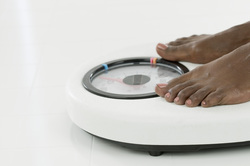
For a long time I had some idea that I wanted to lose weight. I would look in the mirror and did’t like what I saw, my clothes didn't fit anymore and I was in perpetual fear of encountering a health crisis. I knew that something needed to change and as such decided to embark on a weight loss journey albeit rather aimlessly. Restricting this and restricting that in the hopes that something will magically happen for me. The funny thing is I wasn't really sure what I was tying to attain. In fact for many years I had no idea how much I weighed. I spent those years going through the motions without a plan, never succeeding and always frustrated. One day quite by chance I stumbled upon a weight loss challenge and one of the entry requirements was taking a number of different measurements. Needless to say knowing my measurements and knowing what needed to change helped me set a goal and stick to it.
In order for you to know what changes need to be made you will need to measure youreself. This can be done in several
ways.
1. Get on a scale
Many people are afraid of the scale and as a result have no idea how much they weigh. In order to decide what changes need to be made you need to know what your starting point is. This will help you quantify they changes that need to be made and set a definitive goal that you can work towards. Be careful not to get overly obsessed with the scale. Weighing yourself several times a day every day can be a hinderance. Instead, weigh yourself and put the scale away. Only bring the scale out at various check points such as every two weeks or every month.
2. Get a tape measure
You can measure different points on your body but the most important measurement is your waist circumference. According to the National Institute of Health, a waist circumference greater than 35 inches for women and greater than 40 inches for men is
associated with an increased risk for type 2 diabetes, dyslipidemia, hypertension, and cardiovascular disease particularly with a BMI above 25. Other parts of your body you may want to measure include your chest and your hips.
3. Calculate your BMI (Body Mass Index)
Use a BMI calculator to figure out your BMI. I understand that there are numerous debates about the accuracy of using BMI among people of color, extremely short people or extremely muscular people. I am only recommending this as a starting point. A detailed discussion with your personal trainer, nutrition coach or other knowledgeable individual will help you determine its accuracy based on your particular circumstances.
I hope the discussion about obtaining your measurements gets you motivated to measure yourself so you at least know where
you are. This will help determine your weight loss strategy which should include a meal plan. Knowing your starting point will help inform your decision as you set Specific, Measurable, Attainable, Realistic and Timely Goals (See my previous blog post on Setting SMART goals). In the same way you know how much money you have and create and manage your budget, you need to know what your current measurements are in order to monitor and manage your weight loss. If you don’t know where you currently stand, how will you know where you are going? How will you know what you need to do to get there? And more importantly how will you stay motivated and focused?
I encourage you to take each of these measurements today because if it doesn’t get measured it doesn’t get managed.


 RSS Feed
RSS Feed
